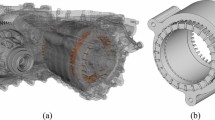Abstract
It had been researched the thermal conductivity and dielectric properties of high thermal conductive (HTC) main insulation for the large and medium generator stator bars. The thermal conductivity was analyzed by orthogonal test for the adhesive composed of BN powders and Tung-maleic-anhydride epoxy resin, and the BN with different particle sizes were used in the adhesive. It analyzed the variation of thermal conductivity for the adhesive composite with different BN powder contents, and the best thermal conductivity in the adhesives was 2.27 W/(m K). The variation of the dielectric properties was analyzed for the HTC adhesive by frequency-domain spectrum. It was detected by scanning electron microscope for the dispersion of the BN particles in TAEP and the bond state between the BN particles. The results indicated that the thermal conductivity of the best adhesives was increased by 13 times, and the other properties were almost the same as that of TAEP. Therefore, the HTC adhesive could be used in the main insulation of the large generator stator bars.







Similar content being viewed by others
References
Pan YM, Fu Q (2017) Research progress and application prospect of high thermal conductive insulation materials for large generators. Insul Mater 50(8):46–52 (in Chinese)
Katayama H, Takahashi S, Nakamura H, Shimada H, Ito H, Coetzee GJ, Claassens FA (2006) A successful retrofit of old turbo-generators having various technical problems. Power-Gen Europe, CIGRE A1–206:1–8
Zhou WY, Qi SH, Li GX, Niu GL, Kou JL (2005) Thermally conductive adhesives. Mater Rev 19(5):26–29, 33 (in Chinese)
Touloukian YS (1970) Specific heat: nonmetallic liquids and gases. Thermophysical Properties of Matter
Zhou WY, Zhang YT (2010) Progress in intrinsic thermal conductive polymers. China Synthetic Resin Plast 27(2):69–73, 84 (in Chinese)
Yim MJ, Paik KW (2006) Recent advances on anisotropic conductive adhesives (acas) for flat panel displays and semiconductor packaging applications. Int J Adhes Adhes 26(5):304–313
Mikdam A, Makradi A (2010) Statistical continuum theory for the effective conductivity of fiber filed polymer composites effect of orientation distribution and aspect ratio. Compos Sci Technol 70(3):510–517
Wang ZB, Lizuka T, Kozako M, Ohki Y, Tanaka T (2011) Development of Epoxy/BN composites with high thermal conductivity part I—sample preparations and thermal conductivity. IEEE Trans Dielectr Electr Insul 18(6):1963–1972
Li KS, Wang Q (2002) Study on thermal conductivity of polymer matrix composites. Polymer Mater Sci Eng 28(4):10–13 (in Chinese)
Zhang FC, Yang JJ, Wu QY, Zhang JA, Wu MY (2012) Study on properties of an EP-PU/nano-SiO2 alcohol-soluble adhesive. China Adhesives 21(8):27–31 (in Chinese)
Zhou WY, Wang CF, Tao A, Wu K, Zhao FJ, Gu HZ (2009) A novel fiber-reinforced palyethlene composite with added silicon nitride particles for enhanced thermal conductivity. Compos A Appl Sci Manuf 40(6–7):830–836
Wattanakul K, Hathaikarn M, Mantaya Y (2011) Effective surface treatments for enhancing the thermal Conductivity of BN-filled epoxy composite. J Apply Polym Sci 119(6):3234–3243
Li KS, Wang Q (2002) Advances in thermal conductive polymeric materials. J Funct Mater 33(2): 136–141, 144 (in Chinese)
Zhou WY (2007) High thermal conductivity and electrical insulation polymeric composites. Northwestern Polytechnical University, Xi’an (in Chinese)
Li CH, Qi SH, Mo JL (2009) Study on environment-friendly BN hybrid phenolic resin. China Adhesives 18(7):12–16 (in Chinese)
Du YF (2012) Preparation and properties of insulating thermal conductive epoxy resin based composites. Taiyuan University of Technology, Taiyuan (in Chinese)
Li H, Tian HD, Cai MC, Gong A, Zhou ZY, Wang CY, Peng ZR (2017) Dielectric properties of graphene-filled epoxy nanocomposite with enhanced thermal conductivity. In: 2017 international symposium on electrical insulating materials (ISEIM), pp 149–152
Quill TJ, Smith MK, Zhou T et al (2018) Thermal and mechanical properties of 3D printed boron nitride—ABS composites. Appl Compos Mater 25:1205–1217. https://doi.org/10.1007/s10443-017-9661-1
Chen QG, Shan ZD, Fu Q, He MH (2017) Electrical ageing characteristics of epoxy-mica insulation of generator based on FDS. Acta Materiae Compositae Sinica 34:1926–1933 (in Chinese)
Fu Q, Shan ZD, Chen QG (2018) Dielectric response research status on ageing characteristics of large electric machinery stator bar main insulation. Large Electric Mach Hydraulic Turbine 1:10–14 (in Chinese)
Tagami N, Hyuga M, Ohki Y, Tanaka T, Harada M, Ochi M (2010) Comparison of dielectric properties between epoxy composites with nanosized clay fillers modified by primary amine and tertiary amine. IEEE Trans Dielectr Electr Insul 17(1):214–220
Zhu XD, Luo SB, Yu SH, Chu BJ, Sun R, Wong CP (2018) Fabricating 3D BT-BN/epoxy composites with high dielectric performance. In: 2018 19th international conference on electronic packaging technology, pp 1213–1218
Shan ZD, Chen QG, Fu Q, Feng C, Huang CW, Zheng W (2019) TSDC measurements to analyze the electrical ageing state of large generator stator bar insulation. Polym Test. https://doi.org/10.1016/j.polymertesting.2019.105901
Jin WF (1997) Dielectric physics (Edition 2), pp 79–81 (in Chinese)
Acknowledgements
This project was supported by the Natural Science Foundation of Heilongjiang Province of China (Grant Number ZD2018011); and State Key Laboratory Breeding Base of Dielectrics Engineering of Harbin University of Science and Technology (Grant Number KF20151101).
Author information
Authors and Affiliations
Corresponding authors
Additional information
Publisher's Note
Springer Nature remains neutral with regard to jurisdictional claims in published maps and institutional affiliations.
Rights and permissions
About this article
Cite this article
Gao, H., Liang, L., Shan, Z. et al. Thermal conductivity and dielectric properties of high thermal conductive adhesives in the large generator insulation materials. Electr Eng 104, 1811–1820 (2022). https://doi.org/10.1007/s00202-021-01434-y
Received:
Accepted:
Published:
Issue Date:
DOI: https://doi.org/10.1007/s00202-021-01434-y




